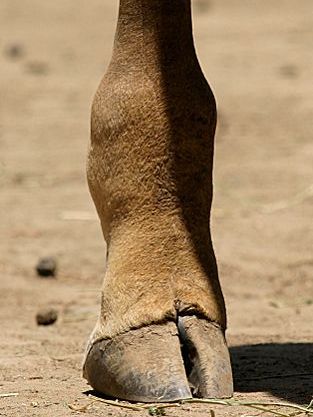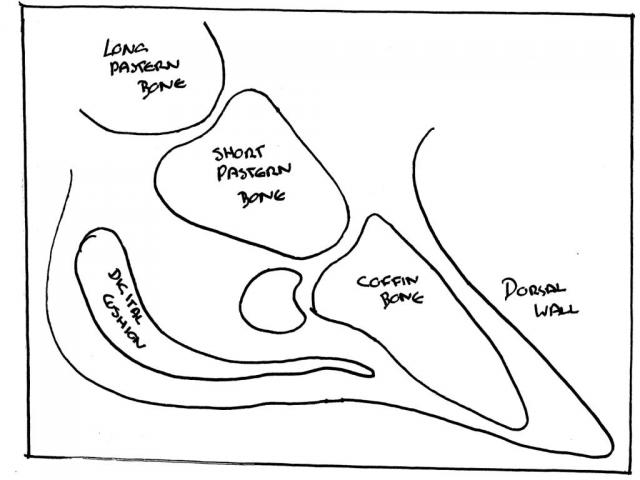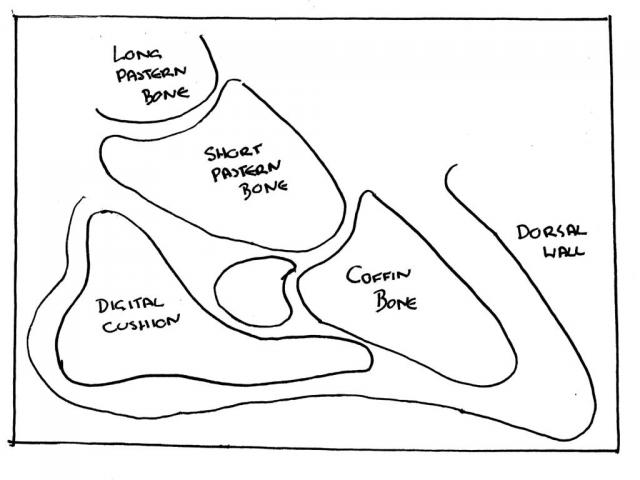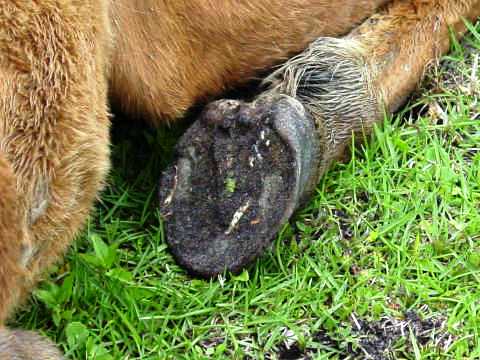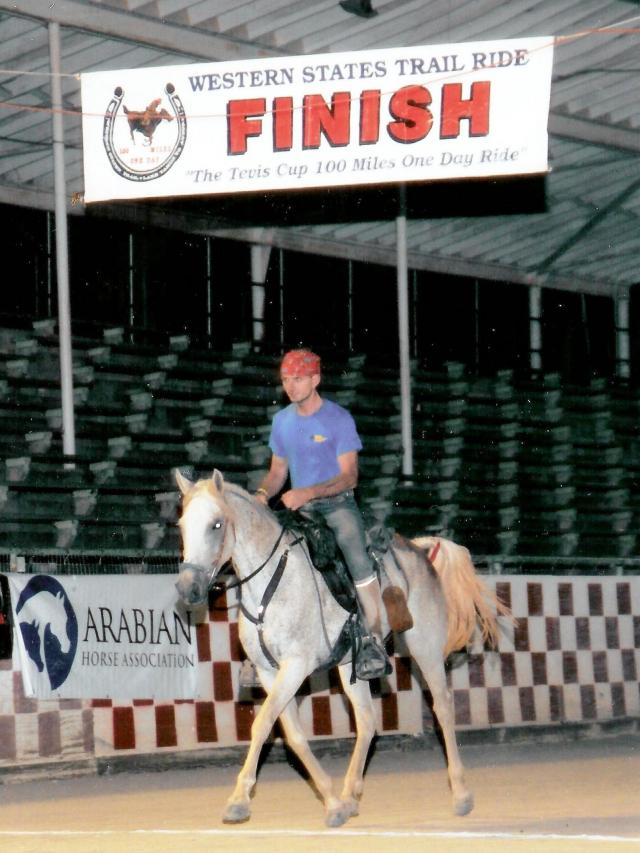The following is an article written by Duncan Mclaughlin a professional hoof care provider, Equine Myofunctional Therapist, trainer and competitive endurance rider who shared his personal insights on a recent esycare inc blog. The article has been widely enjoyed by those exploring natural hoof care. He has given us permission to list his blog article here too.
Is Concussion Really A Problem?
Tuesday, February 16, 2010 by
| "Your eye and ideas are not nearly as good as nature's." James Rooney |
We have all seen them, those insidious concussion rings that appear in the hoof wall following an endurance ride, gradually moving down with the growing hoof capsule. Sometimes they even manifest as horizontal concussion cracks. They look ugly and they scream: Damage! And then, there is all that long-term concussive wear and tear on joints leading to inevitable arthritic change. Not surprisingly, managing concussion is often considered the primary soundness issue for your endurance horse over his career.
|
But need it be so? To answer this question, let's first consider how the hoof functions. Of course, as any internet search soon shows, there are about a bazillion or so theories on how the hoof functions and how to best manage and dress the hoof for optimal performance. For any one theory of hoof function you will soon find another in complete contradiction. However, all the different theories can be categorised into two basic models based on the distribution of weight through the hoof. 1. Whole Of Foot Under this model, your horse's weight simply falls, via the skeleton, to the ground through all components of the hoof (wall, sole, bars, frog), which share in the distribution of that weight. The coffin bone is the load-bearing structure. Under this model, factors external to the hoof, such as the amount of daily movement, the living and working terrain, conformational traits, and the presence/absence of hoof protection, are considered to determine which hoof structures are trimmed or left untouched. The aim is to distribute weight across all hoof components, including the caudal hoof (digital cushion, ungual cartilages), to optimise correct coffin bone loading within the hoof in motion and at rest. 2. Lamellar Sling Under this model, your horse's weight falls through to his coffin bone, which is in turn suspended in a 'sling' by way of the close interweaving of the epidermal (hoof wall) and dermal (inner hoof) lamellae. Under this model, the hoof wall is the primary weight bearing structure, and the focus is on angles and measurements of the hoof in isolation to both your attached horse and his living environment. Obviously this model is implicit in all farriery: attaching a shoe mandates the hoof wall as the only weight-bearing structure. Some vets and researchers also use this model. For example, the work of much-quoted laminitis researcher Chris Pollitt DVM is based on this model, which he describes as the 'lamellar corium - distal phalanx attachment apparatus'. Most schools of barefoot trimming use methods based on the Whole Of Foot model. Rightly so - there is good reason to be skeptical of the Lamellar Sling model: 1. Despite the extensive area of interconnecting epidermal (hoof wall) and dermal (inner hoof) lamellae, around about a square meter per hoof, there is no reason to believe that, as the primary (or singular) weight-bearing mechanism, this soft tissue connection is able to withstand the repetitive forces generated by a moving horse over a long term performance career. 2. Horses are not intergalactic visitors, without an evolutionary history. No other terrestrial mammal suspends its weight from its epidermis! Horses evolved from three-toed ancestors that distributed weight through the whole of each of their three toes. It is hard to imagine, given this starting point, any type of selection pressure under which a 'lamellar sling' would or could evolve.
Like your horse, giraffes evolved by fusing and lengthening of the bones of the lower limbs but has two toes encased in horn instead of one. 3. More pragmatically, schools of barefoot trimming based on the Lamellar Sling model, for example those based on Hiltrud Strasser DVM's theory of ' hoof mechanism', continue to be spectacularly unsuccessful at producing sound horses able to perform any useful amount of work. Bone requires loading - it loves to be stressed. But it needs to be stressed along the line(s) of compression for which it evolved. Your horse's coffin bone is his loading hoof structure: trimmers of successful barefoot performance horses trim to the coffin bone. In particular they look to maintain/develop a hoof where the medio-lateral and anterio-posterior balance facilitate quick and easy rotation of the coffin bone during the support-phase of movement (see the previous post on positive dissociation for a reminder on why short stance phases are important) and where the coffin bone sits high in a short hoof capsule.
Trimmed (or shod) in accordance with the Lamellar Sling model, your horse's weight is suspended primarily or solely from the hoof wall. The soft tissue, the epidermal and dermal lamellae, connecting the hoof capsule to the internal hoof are not able to withstand repetitive pressures associated with movement and the hoof capsule is pushed (by the ground) up higher and higher around the coffin bone; the hoof appears long. In the absence of ground stimulation the thin sole and under-developed caudal hoof (frog, bars, digital cushion, ungual cartilages) causes the coffin bone to sit low (digital descent) in the already elongated hoof capsule: There is no compression of the coffin bone, via the sole. Instead, it is placed under tension from the lamellar sling - a quite different force than the compression forces the coffin bone evolved to cope with. The distal phalangeal joint (between the short pastern and the coffin bone) is encased within the long hoof capsule, reducing range of motion. Further, to move optimally, the coffin bone pivots over a specific balance point in the hoof, above the pericuneal cortex, during support-phase of movement. When your horse has a long toe, the extensor processes of the coffin bone elongate in an attempt to rebalance the hoof and maintain position of this pivot point. This results in what we commonly call under-run heels: It is not necessarily that the heels are actually under-run but that the extensor processes of the coffin bone have elongated backward, over the heel, in an attempt to balance the long toe.
Trimmed in accordance with the Whole Of Hoof model, your horse will have increased concavity, sole thickness and caudal hoof (frog, digital cushion, ungual cartilages) development within a relatively small hoof capsule. The coffin bone sits high in the hoof capsule with the happy consequence that the distal phalangeal joint is about level with the coronet band, enabling that very fluid movement peculiar to barefoot horses. The focus using the Whole Of Foot model is not how much the hoof wall (or any other hoof component) is loaded or unloaded, this depends on a range of factors, but to ensure the coffin bone is correctly loaded. As a rule of thumb, we want the hairline above the extensor processes of the coffin bone to be around 10mm distance. If this distance is 14mm or greater, your horse clearly has a descended coffin bone (digital descent).
Despite the very long walls on the foot of this soft-terrain living Cumberland Island feral horse, correct anterio-posterior balance is maintained. The long heels balance the long toe to ensure correct pivot point and the coffin bone is still loaded as the very soft terrain provides a 'solar plug' which fills in the area under the sole between the wall. In addition the wall at the toe cuts into the soft ground, allowing full range of movement without excessive dorsiflexion of the fetlock. Photo from Cindy Sullivan's Tribe Equus website. Our discussion about concussion and hoof structure must include mention of the bars. For our performance horse, we want short, straight bars that bear load during support-phase. In a well developed hoof the ungual cartilages are thickened with fibrous cartilage that sits over the bars. On weight-bearing the bars are pushed up and work in conjunction with the ungual cartilages to expand the top of the hoof. Loaded bars are also involved in the transfer of energy to the digital cushion. Bar loading is vital for reducing concussion (as your good footed horse actually experiences negative pressure in the hoof on heel strike, it sucks onto the ground - refer to Prof. Robert Bowker's work on good footed horses for more detailed explanation). Those trimmers who are misguidedly excavating bars in order to relieve 'navicular syndrome' or wall flares at the quarters, are actually increasing concussion and preventing caudal heel development. No amount of trimming can develop short, straight, functional bars. Functional bars result, as if by magic, when the coffin bone is carried high in the hoof capsule; a result of well developed soles and caudal hoof structures. Similarly, it is not possible to trim concavity into the sole. Again, concavity arises when the thick sole and well developed caudal hoof push the coffin bone higher in the short hoof capsule. Carving out concavity in a parody of correct hoof function simply thins the sole further, preventing your horse from performing any useful amount of work. In particular, the sole under the coffin bone, rich in proteoglycans that function to hydrate the solar tissue and so absorb concussion, should not be compromised. So, trimmed by methods that accord with the Whole Of Hoof model, your horse will move in a biomechanically correct and comfortable manner. But what do we mean by 'moving comfortably'? In a recent internet chat-group discussion, one observer of Australia's desert brumbies mentioned that some of these horses would take 'ouchy' steps when trotting on rocks and gravel. The implication was this was a bad thing, in which case, this observer misses the point. The fact that desert brumbies take some ouchy steps actually demonstrates extremely effective hoof function. When I take my shoes off and go for a run, I can stride along quite comfortably but if my foot begins to land on a sharp rock, I immediately take an ouchy step - I limp- as sensory nerves instigate a reflex action to prevent my foot from weight-bearing. The ouchy step is the perfect (though energetically inefficient) way to move when treading on a sharp rock and prevents both me and the brumby from getting a bruised sole. It certainly does not mean either of us are unsound or in pain. Indeed, failure to take an ouchy step when treading on a rock is, or should be, the real concern; go watch the shod horses at your next endurance ride… The same sensory mechanisms explain why terrestrial mammals take longer steps on soft ground compared to shorter steps on hard ground. When landing on a soft surface the hoof instinctively comes down harder in order to load the coffin bone and to find a stable platform to support the support-phase: cushioning (turf, sand, padded boots or shoes) reduces sensation, not concussion. Your barefoot horse, trimmed to appropriately load the coffin bone, trotting with shorter strides on an tar road demonstrates the correct biomechanical form and function to dissipate concussion. On a softer surface, say a grassy field, he will need to move with a more lengthened stride - that is, increased force - in order to correctly load the coffin bone. Accepting that his movement will change on different surfaces, you should always remain alert that your barefoot horse travels in a comfortable manner. Anytime your horse is not moving comfortably, for example, continuing to tip-toe along a gravel road, he is using muscular effort to change his way of going. This is not only an incredible waste of energy, with potential for muscular overuse injury, but also puts improper stress on bones and joints: joint injuries are not overuse injuries, they are improper use injuries where muscles, via tendons, inappropriately strain the bones comprising the joint. If your barefoot horse is struggling in anyway with the distance or terrain you ride him over, you should boot him. A number of boot models are appropriate for endurance horses. I prefer the Easyboot Glove for endurance (and whenever possible for rehabbing horses with laminitis, 'navicular syndrome', and similar hoof pathologies). I particularly like the Glove because: 1. Rubber is the ideal surface to encourage perfusion of blood through the hoof. In his lecture to students in the 2009 Diploma of Equine Podiotherapy, Prof. Bowker discussed how the hoof interacts with a rubber surface, increasing surface area (more than on any other substrate). Even small increases in surface area will drastically reduce overall pressure. 2. The firm rubber surface evens out the actual terrain the horse is moving over. On soft terrain such as deep turf or sand, the rubber provides a more resistant landing preventing the limbs from hyper-extending in an attempt to find a stable landing place. On very hard terrain such a rock or tar, the rubber creates a more cushioned landing, allowing your horse to move out comfortably with lengthened stride, which is much less fatiguing for the rider. 3. There is a good breakover, relative to the solar area, moulded into the boot (the breakover is much better than the breakover of the actual hoof for the majority of domestic horses). As discussed previously, a quick breakover ensures correct biomechanical action, including heel first landings. Comfortable heel first landings are the way to develop the caudal hoof. Stimulation of receptors in the frog, heel bulb and ungual cartilages encourage development of the digital cushion. The digital cushion of horses with no frog, sole and heel stimulation is a weak mass of connective tissue. By contrast, stimulated with whole-hoof ground-contact and heel first landing, the digital cushion develops a web of fibrous cartilage that radiates out and up from its origin near the junction of the deep digital flexor tendon with the coffin bone. On a well developed hoof this fibrocartilagenous web extends up past the navicular bone and creates a resilient floor across the entire base of the digital cushion. More fibrocartilage means more energy dissipation and less concussion. Further, the ungual cartilages of the coffin bone also lay down (thicken with) fibrocartilage in response to stimulation. Well developed ungual cartilages approach an inch in thickness and are crucial in reducing concussion as only thick ungual cartilages encase intricate complexes of blood vessels within: these act as hydraulic energy dissipaters. When these complexes merely sit along the internal edge of thin ungual cartilages, their function as shock absorbers are compromised. Ideally, you want your horse to have close to one third of its hoof volume taken up by these caudal hoof components. In shod horses the caudal hoof volume is commonly less than 20% and sometimes as little as 10%. Used on a horse with a well developed caudal hoof, as found with many barefoot endurance horses, I will further rasp back the Glove breakover a few millimeters more to create an improved boot breakover for working horses - this saves waiting for the breakover to wear in over time. 4. The comfort provided by the boot means the horse can be ridden more. More steps means more blood perfusion through the hoof and more development of the caudal hoof. In effect, you can ride your horse to increased soundness (the opposite of the traditional view that an endurance horse only has so many miles in him).
GE Lady, at the end of a hundred mile ride, wearing Easyboot Glue-Ons with solar packing. Despite a strenuous and rocky 100 miles, Lady continues to move with positive dissociation. Her soft and relaxed musculature, in particular the raised withers and forward reaching poll, indicate continued excellent biomechanical form despite her exertions. Of course, it is not all sweetness and light. All hoof boots have a flat inner-sole. If most of your horse's time in action is spent in boots (as is often the case for endurance horses, who cover much more ground in training than when loafing around the paddock), you will see the hoof adapt to this flat surface; primarily by losing concavity. The coffin bone does not want to 'bottom out', that is, over-descend (and come into tension as per the Lamellar Sling model), as is possible with a concave foot on a hard, flat surface. The sole with thicken further, particularly in toward the frog, filling in the concavity. Not in itself a problem except that this extra thick sole has potential to overload the coffin bone when your horse is unbooted. For many boots, the issue is avoided completely by using a dome pad as a 'solar plug', providing an artificial terrain that maintains concavity (in fact dome pads are so effective at this I have often incorporated them in the recovery of laminitic horses to riding soundness). Dome pads are not available for the Glove but it is easy to create custom pads for your horse using Goober Glue. Further, cushioning reduces sensation not concussion. Booting, and particularly booting with pads (of whatever form), reduces the sensory feedback from the hoof. More than likely your horse will want to really stride along when booted. It is appropriate for you, as the rider, to slightly temper this more extravagant movement and somewhat contain his length of stride. But don't worry too much. So long as the boot allows (or even improves) correct movement (reducing support-phase, lengthening flight phase) then any increased concussion forces are easily dissipated according to nature's design. Remember, it is correct biomechanical form and function that dissipates concussion - get these right and concussion simply ceases to be an issue, no matter how many miles you ride. |

